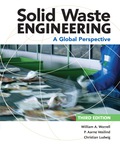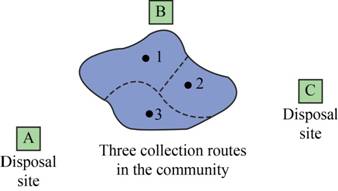
Concept explainers
The objective function and the constraint equations for minimizing the transportation cost for the community.
Answer to Problem 3.16P
The objective function for minimizing the transportation cost for the community is
The constraint equations are
Explanation of Solution
Given:
The community is shown in the figure below:

Figure (1)
Assume that the cost of disposal is the same at both the disposal sites, and therefore, the disposal cost can be ignored.
Write the expression for the general objective equation for transportation cost.
Here, the transportation cost is
In Figure-(1) there are three routes, this means there are three sources and two disposal sites A and B.
Substitute
From the given data disposal cost can be ignored.
Thus, expand the above equation to find the transportation cost.
Write the
The waste hauled is equal to or less than the capacity of the disposal sites.
Here, the disposal site is
Expand Equation (II) to find the
Write the
The waste hauled is equal to the capacity of the disposal sites.
Here, the disposal site is
Expand Equation (III) to find the
The quantity of the waste hauled out must be positive.
Conclusion:
Thus, the objective function for minimizing the transportation cost for the community is
The constraint equations are
Want to see more full solutions like this?
- Calculate ALL nodal displacements and ALL the member forces in the truss. Please use the ID's noted in the truss diagram and draw relevant FBD'sarrow_forwardStructural analysis qarrow_forwardIn the figure, all loads are factored, and the uniform load includes self-weight. Use #3stirrups. fc′ = 4 ksi, and fy = 75 ksi.(a) What stirrup spacing is required at section A?(b) How will this spacing change at section B?(c) Indicate the region of the beam where stirrups are not required.arrow_forward
- Fluid mechanics question Draw a free body diagram and properly explain each starrow_forwardThe box beam in the figure is reinforced with #4 U-stirrups in each web. f c′ = 3.5 ksi, andfy = 60 ksi.(a) What is the design shear capacity of the cross section?Hint: Find concrete and stirrup strengths separately, and then find the total capacity.(b) If the total applied factored shear force at the section is 220 kip, please comment onthe adequacy of this shear design.Hint: Compare the total capacity from (b) with the shear force.2. In the figure, all loads are factored, and the uniform load includes self-weight. Use #3stirrups. fc′ = 4 ksi, and fy = 75 ksi.(a) What stirrup spacing is required at section A?(b) How will this spacing change at section B?(c) Indicate the region of the beam where stirrups are not required.arrow_forwardStructural analysis questionarrow_forward
- 1) Assuming that water at 20 C is flowing through the system at a constant flow rate of 2 ft³/sec and neglecting viscous effects, calculate the EL and HGL at points A, B, and C. Sketch the EL and HGL alongside the diagram. A ZA = 55 ft D₁ = 3 in B D₂ = 6 in C 2) What is the elevation at point C in the above figure? 3) Using the figure from problem 1, sketch the EL and HGL accounting for both major and minor losses. Note that the flow rate will change due to the introduction of friction (we will explore this further in the coming weeks). You do not need to calculate the values of EL and HGL.arrow_forward8) Carbon dioxide at 20 C is transported through a pipe of 0.1 m in diameter. What is the maximum flow rate possible to achieve laminar flow?arrow_forward7) In the below diagram, the pipe diameter is 10 cm and the flow rate in the pipe is 0.3 m³/sec. At this flow rate, the pump will generate 90 m of head. The pressure at point A is 500 Pa and the water in the pipe is at 60 C. a) Taking the datum to be at the centerline of the pump, calculate the EL and HGL at points A and B, neglecting friction. b) What is the pressure at point B? A P Barrow_forward
- C 7-33. The beam is constructed from two boards fastened together at the top and bottom with three rows of nails spaced every 8 in. If an internal shear force of V = 800 lb is applied to the boards, determine the shear force resisted by each nail. Temps to rise Sunday **SW4 88AN SID IDI FI 2 F2 # * F3 3 日 $ 4 Q W A S F4 B Q Search F7 40 F5 F6 & Jo % 5 6 7 E R T Y ப * F G H J FB IA F9 IAA FIO FII ( B 9 ㅁ Z X C V B N M ALT H FI2 8 in. =1 } ㅁ P [ ] L 8 in. 2 in. 4 in. V 9 in. DELETE BACKSPACE NUM LOCK I T ENTER PAUSE SHIFT ALT CTRL V 7 HOME الحاد E I ENDarrow_forwardG 6-114. The cantilever wide-flange steel beam is subjected to the concentrated force of P = 600 N at its end. Determine the maximum bending stress developed in the beam at section A. 10 mm 150 mm 10 mm y Temps to rise Sunday @ 2 *F3 *F2 $ # 4 3 Q Search 1+ F7 48 F5 FB F4 & % 5 6 7 4 W E R T Y ப IAA FB * 8 9 ► I 30° FIO Q FII FI2 + == 200 mm HI [ ] A 5 ㅁ F G H J K L ? PAUSE Z X C V B N M ALT ALT CTRL -10 mm DELETE 2 m A BACKSPACE NUM LOCK 2:27 PM 4/10/2025 INSERT PE 7 日 9 HOME PG U ENTER 4 S SHIFT 2 END INSarrow_forward*7-16. allow The beam has a square cross section and is made of wood having an allowable shear stress of T - 1.4 ksi. If it is subjected to a shear of V = 1.5 kip, determine the smallest dimension a of its sides. 2 Temps to rise Sunday Fl BID (0) 4 3 2 Q Search F4 40 FS * & % S 6 7 D W E R T Y ப A S ㅁ F G H J Z X C V B N ALT の 日 Σ H FID FII FIE L ALT CTAL [ ] PAUSE V-1.5 kip BELETE BACKSPACE NUM LOCA 7 HOME ENTER F SHIFT ENDarrow_forward
 Fundamentals Of Construction EstimatingCivil EngineeringISBN:9781337399395Author:Pratt, David J.Publisher:Cengage,
Fundamentals Of Construction EstimatingCivil EngineeringISBN:9781337399395Author:Pratt, David J.Publisher:Cengage, Solid Waste EngineeringCivil EngineeringISBN:9781305635203Author:Worrell, William A.Publisher:Cengage Learning,
Solid Waste EngineeringCivil EngineeringISBN:9781305635203Author:Worrell, William A.Publisher:Cengage Learning, Traffic and Highway EngineeringCivil EngineeringISBN:9781305156241Author:Garber, Nicholas J.Publisher:Cengage Learning
Traffic and Highway EngineeringCivil EngineeringISBN:9781305156241Author:Garber, Nicholas J.Publisher:Cengage Learning


